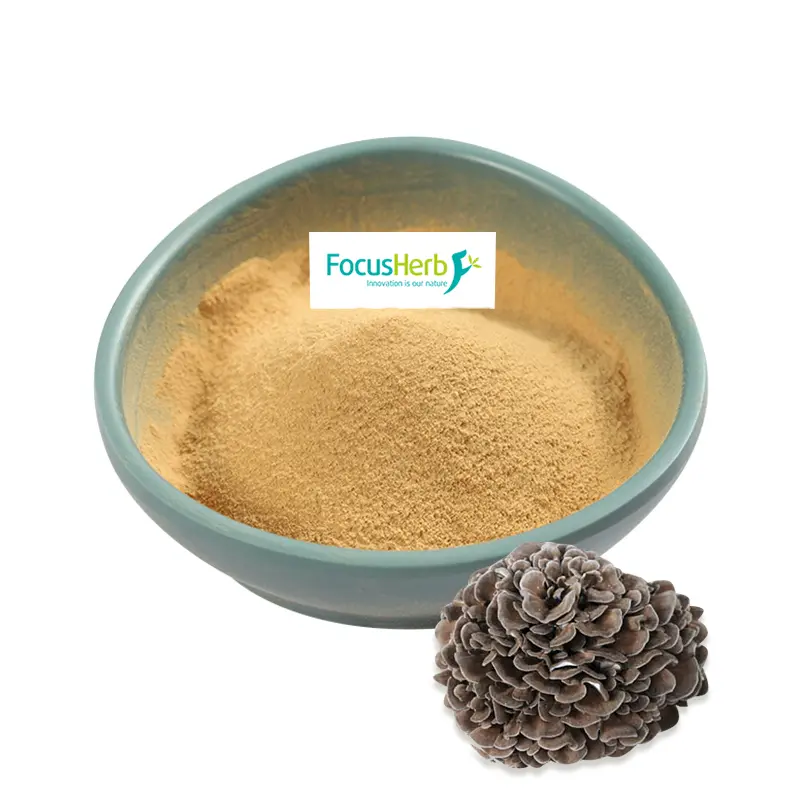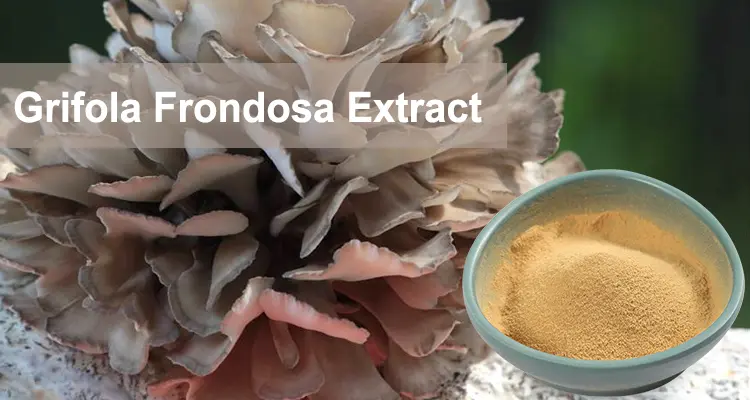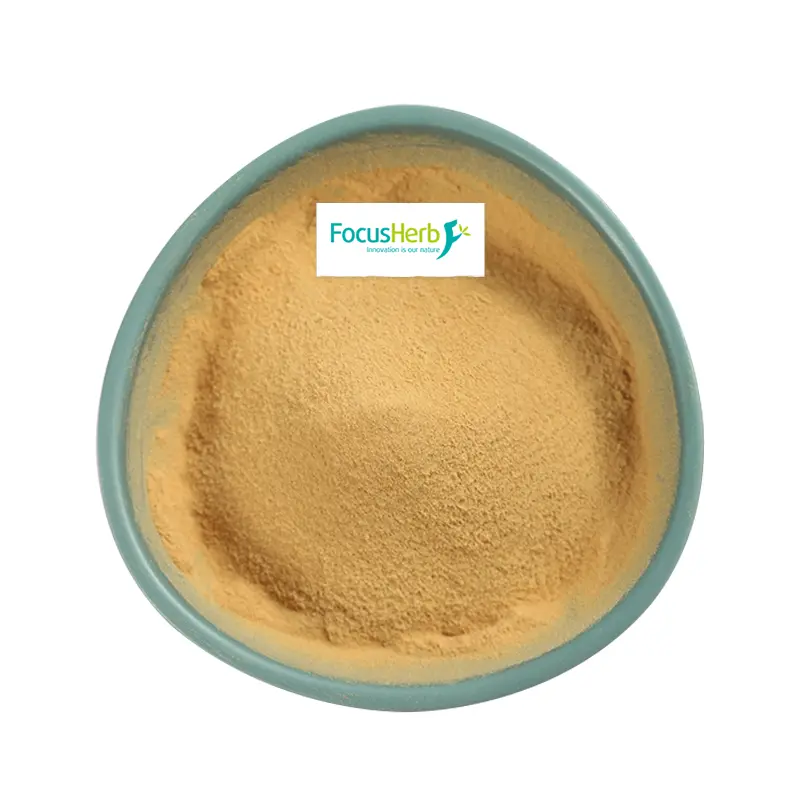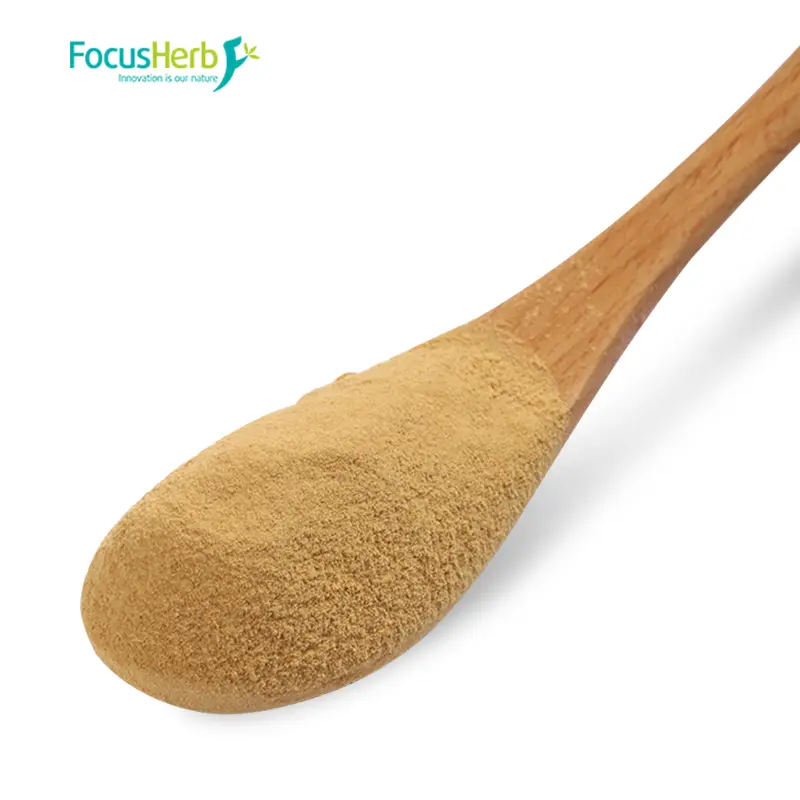Grifola frondosa (Dicks.) Gray, commonly known as “maitake mushroom” or “maitake mushroom,” is a taxonomically classified genus Grifola in the family Mycopodiaceae. It is a mushroom used both as food and medicine. During summer and autumn, it grows wild on the roots or stumps of Fagaceae trees, such as chestnut, oak, Castanopsis, and Cyclobalanopsis, as well as broad-leaved trees. It is widely distributed in China, Japan, Singapore, and Europe, with concentrations in Guizhou, Hebei, Yunnan, Sichuan, Fujian, and Jilin in China. Its tender flesh, flavored like shredded chicken, is delicious and has a unique aroma, earning it the nickname “Prince of Edible Mushrooms.”
Grifola pollen is a powdered substance made from the fruiting bodies or mycelium of Grifola frondosa. It retains all of the nutrients found in the plant, making it more convenient to consume and suitable for a wide range of applications, including food, health supplements, and pharmaceuticals.
Rich Nutritional Value
Maitake Mushroom Extact contains numerous beneficial nutrients, making it a prime example of nutritional richness. Testing revealed that every 100 grams of dried grifola frondosa contains 25.2 grams of protein and 18.68 grams of all 18 essential amino acids, with 45.5% being essential amino acids. This ratio makes grifola frondosa protein a superior nutritional source. Compared to common shiitake mushrooms, grifola frondosa contains twice the protein and amino acid content, potentially promoting healthy physical growth and intellectual development in children. Its arginine and lysine content is also higher than that of enoki mushrooms. Furthermore, grifola frondosa contains high levels of aspartic acid and glutamic acid, which are associated with umami. This not only gives it its unique umami flavor but also stimulates appetite, earning it the nickname “Prince of Edible Mushrooms.”
Grifola frondosa pollen also excels in terms of vitamins. It is rich in vitamin E, B vitamins, and vitamin C. Its vitamin E content reaches 109.7 mg/100 g, ranking high among foods and second only to sesame oil. It also contains 1.47 mg/100 g of vitamin B1, 0.72 mg/100 g of vitamin B2, 17.0 mg/100 g of vitamin C, and 4.5 mg/100 g of carotene. Compared to other edible fungi, maitake pollen contains approximately 10-20 times more vitamin E and vitamin E, and 3-5 times more vitamin C. These vitamins play a key role in antioxidant defense, maintaining normal nervous system function, and promoting collagen synthesis.
Maitake pollen also contains a variety of minerals, such as potassium, phosphorus, iron, zinc, calcium, copper, selenium, and chromium. Zinc is crucial for brain development and visual acuity, and it promotes wound healing. Selenium has antioxidant, liver-protecting, and cancer-preventing properties, and can also prevent Keshan disease, Kashin-Beck disease, and certain heart diseases. Chromium helps maintain normal glucose metabolism and plays a role in preventing diabetes. Furthermore, the calcium and vitamin D in maitake pollen work synergistically to effectively prevent rickets. Iron and copper can prevent anemia. Its rich dietary fiber content, at 33.7 grams per 100 grams, helps promote intestinal motility, prevent constipation, and reduce the risk of cardiovascular disease.
Powerful Benefits and Effects
Health and Wellness
Maitake pollen has numerous health and wellness benefits, playing a positive role in improving human health. It is particularly effective in strengthening the spleen and stimulating the appetite. Rich in aspartic acid and glutamic acid, which are associated with umami, it effectively stimulates the taste buds and increases appetite, making it a natural remedy for those with poor appetite. Regular consumption of foods made with maitake pollen can improve digestion and enhance nutrient absorption. Diuresis and swelling reduction are also important benefits of maitake pollen. From a Traditional Chinese Medicine (TCM) perspective, it regulates fluid metabolism and alleviates symptoms such as edema caused by spleen and kidney yang deficiency, particularly lower limb edema, as well as urinary incontinence, athlete’s foot, and ascites from cirrhosis. It acts as the body’s “drainage expert,” helping to excrete excess water, maintain fluid balance, and alleviate the discomfort caused by edema.
Maitake pollen can also significantly boost immunity. Rich in nutrients such as protein, amino acids, vitamins, and minerals, it forms the building blocks of a healthy immune system. Its active ingredient, α-glucan, enhances immune cell activity, acting like a “cardiac tonic,” helping the body defend against viruses like influenza, boosting immunity, and reducing the risk of illness.
Maitake pollen also excels at boosting brain function. Its high zinc content is essential for brain development and maintaining visual acuity. Zinc acts like a catalyst for brain development, promoting the growth and connection of nerve cells, enhancing memory and learning abilities. It’s ideal for children in their growth and developmental stages, providing strong support for their intellectual development.
Grifola frondosa pollen also plays a role in regulating blood sugar. The beta-(1-3) D-glucan and beta-(1-6) D-glucan protein compounds in Grifola frondosa polysaccharides, as well as the unsaturated fatty acids in the extract, such as trilinolein, can reduce blood glucose and enhance the body’s sensitivity to insulin. This acts like a stabilizer for the blood sugar regulation system, helping to control blood sugar levels and prevent and improve diabetes.
Grifola frondosa pollen can also prevent a variety of diseases. Rich in iron, copper, and vitamin C, it can prevent anemia, scurvy, vitiligo, arteriosclerosis, and cerebral thrombosis. Its high selenium and chromium content protects the liver and pancreas, preventing cirrhosis and diabetes. It also prevents Keshan disease, Kashin-Beck disease, and certain heart diseases. The synergistic effects of calcium and vitamin D effectively prevent and treat rickets. The high levels of vitamin E and selenium complement each other, giving it anti-aging properties and enhancing memory and sensitivity, safeguarding human health.
Potential Medicinal Value
In traditional Chinese medicine, maitake mushroom is considered a potent herb, strengthening the spleen and replenishing vital energy. It can be used to treat all symptoms of spleen deficiency, and is particularly suitable for those with spleen deficiency and dampness. For patients experiencing symptoms of fatigue, poor appetite, dizziness, heaviness in the head, loose stools, and other TCM symptoms, such as an enlarged tongue, a pale tongue coating, and a deep, weak pulse, maitake mushroom can improve symptoms by strengthening the spleen. Modern research has further revealed the potential medicinal value of maitake pollen. It exhibits unique anti-cancer effects, activating immune cells such as phagocytes, natural killer cells, and cytotoxic T cells, inducing the secretion of cytokines such as leukocytes, interferon-γ, and tumor necrosis factor-α, and inducing apoptosis in cancer cells. In clinical practice, maitake pollen, when used in combination with traditional chemotherapy drugs, can enhance their efficacy while mitigating their toxic side effects, offering new hope for cancer patients. For example, in some cancer treatment cases, maitake pollen has significantly reduced adverse chemotherapy effects and improved quality of life.
Maitake pollen also improves vascular microcirculation and has a therapeutic effect on conditions such as hypertension and liver cirrhosis. It acts as a “scavenger” and “repairer” for blood vessels, clearing impurities, enhancing their elasticity, improving blood circulation, reducing the risk of cardiovascular disease, and maintaining overall health.
Diverse Consumption Methods
Grifola frondosa pollen can be consumed in a variety of ways, catering to diverse tastes and needs. The simplest way is to consume it directly. After opening the package, chew it carefully to savor the unique, fresh, and fragrant flavor of the plant and experience its authentic nutritional benefits. However, be careful to limit the amount when consuming it directly to avoid excessive intake, which can lead to a taste irritation.
Soaking it in water is also a common method. Place an appropriate amount of grifola frondosa pollen in a cup, add 70-80°C hot water, stir well, and drink. This allows the nutrients in the grifola frondosa pollen to fully dissolve in the water while preserving their activity. The water temperature is crucial; too high a temperature may destroy the nutrients, while too low a temperature may not fully activate its flavor and benefits. If the grifola frondosa pollen alone tastes bland, add honey, goji berries, or other ingredients to enhance the flavor and health benefits. For example, honey enhances the taste and moisturizes the skin; adding goji berries enhances the liver and kidney nourishing properties. Maitake pollen also proves useful in cooking. When making soups, whether light vegetable or rich meat, adding an appropriate amount of maitake pollen and stirring well before serving can enhance the flavor and nutritional value of the soup. For example, sprinkling a small amount of maitake pollen on egg custard not only improves its texture but also adds nutritional value. When making fillings, such as dumplings or buns, mixing maitake pollen with meat or vegetable fillings adds a unique flavor, making the dumplings and buns even more delicious.
Furthermore, maitake pollen can be made into a solid beverage, making it portable and easy to consume on the go. There are a variety of maitake pollen solid beverages available on the market, typically formulated with other nutrients such as Cordyceps militaris powder, pomegranate powder, sucralose, and resistant dextrin. These solid beverages typically require only warm water. Be sure to follow the water temperature instructions on the product to ensure the effective nutrients are fully released. For example, a certain brand of Maitake mushroom powder beverage requires a water temperature of 70-80°C when brewing. This maximizes the preservation of nutrients and maximizes their health benefits.
Market Status and Pricing
With rising health awareness and a growing demand for natural, nutritious, and functional foods, Maitake Mushroom Extact is becoming increasingly popular in the market due to its rich nutritional value and significant health benefits. In China, Maitake Mushroom Extact is available not only in major health product stores and pharmacies, but also in the health food sections of some large supermarkets. Online sales channels are even more plentiful, with numerous sellers on major e-commerce platforms such as JD.com, Taobao, and Pinduoduo. Maitake Mushroom Extact is also gaining popularity internationally, particularly in health-conscious countries and regions such as Japan, South Korea, and Europe and the United States, where it has garnered widespread attention and favor among consumers.
The price of Maitake Mushroom Extact varies depending on its quality, purity, packaging, and sales channel. Generally speaking, ordinary quality maitake pollen in a small package (such as 100 grams) costs around 50-100 yuan; medium quality maitake pollen in a 250-gram package costs around 150-300 yuan; and high quality maitake pollen in a 500-gram package can cost 500-1000 yuan or even more. In some wholesale markets, larger quantities are discounted, leading to more affordable prices. For example, on Alibaba’s wholesale platform, some vendors offer maitake pollen with a 10:1 maitake extract for as low as 50-60 yuan per kilogram. Meanwhile, on Huinong.com, Zhejiang Longquan Zhengda Biotechnology Co., Ltd. sells its Zhengda ultrafine maitake pollen for 260 yuan per kilogram, with a minimum order of 10 kilograms. The prices of some solid beverages made from maitake pollen with other nutrients added to them may fluctuate depending on the brand and formula. A common box (30-50 strips) costs around 100-300 yuan.
Selection and Storage Guide
Selection Methods
When selecting maitake pollen, there are several factors to consider. High-quality maitake pollen has a uniform color, typically light yellow or light brown. If the color is too bright, too dull, or even has a mottled appearance, it is likely poor quality or improperly processed. For example, a darker color may indicate excessive heating during processing, resulting in a loss of nutrients; a lighter color may indicate adulteration.
Smell is also crucial. Authentic maitake pollen should have the distinctive fragrance of maitake trees. If it smells pungent, sour, or otherwise unpleasant, it may be spoiled or contaminated, so avoid purchasing it.
Feel the texture by hand. Good maitake pollen should be fine and uniform, free of noticeable graininess or clumping. If it feels rough, has large particles, or easily clumps, it may be due to poor processing or improper storage, resulting in moisture.
When purchasing, it is also important to choose a reputable channel and a well-known brand. Products from legitimate channels typically undergo rigorous quality inspections and have complete production information and quality assurance, ensuring the highest possible quality and safety. For example, the quality of maitake pollen sold in some large supermarkets and pharmacies is relatively well-established. Well-known brands prioritize quality control during the production process and have a strong reputation and credibility. Consumers can check product reviews, certifications, and other information to understand the brand’s reliability.
Storage Tips
Storage of maitake pollen is crucial to preserving its quality and nutrients. If consumed within a short period (1-2 months), store it in a dry, cool, well-ventilated area at room temperature, away from direct sunlight and heat sources to prevent thermal deterioration. For example, you can store it in a kitchen cupboard, but be careful not to place it near heating appliances such as stoves. Also, ensure the storage environment is odor-free to prevent the pollen from absorbing other odors, which could affect its flavor and quality.
For long-term storage of maitake pollen, refrigeration is a better option. Seal the maitake pollen tightly and store it in the refrigerator at a temperature between 0 and 5°C. This will effectively extend its shelf life, typically lasting 1 to 2 years. It’s recommended to use an airtight bag or container to remove as much air as possible to minimize the effects of oxygen on the pollen.
If it’s not going to be consumed for an extended period, freezing it can maximize its nutritional value. Place the pollen in a sealed bag or container, remove the air, and then store it in the freezer at a temperature below -20°C. Under these conditions, maitake pollen can be stored for several years. However, it’s important to allow frozen maitake pollen to thaw naturally before consumption. Avoid repeated freezing and thawing, as this can damage the pollen’s structure and nutritional content, leading to a decrease in quality.
Future Outlook
With increasing interest in health and wellness, maitake pollen, as a nutritious and versatile health food, holds great promise for future development. In the food industry, it is expected to be increasingly used in the development of various innovative foods, such as baked goods, snacks, and meal replacement powders, offering consumers more delicious and nutritious options. In the health supplement market, maitake pollen, with its immune-boosting and blood sugar-regulating properties, offers opportunities for the development of more targeted products to meet the health needs of diverse populations. In the pharmaceutical field, with continued research into its medicinal value, maitake pollen may play a greater role in adjunctive cancer treatment and cardiovascular disease prevention.
However, despite its promising prospects, maitake pollen also faces challenges, such as the need to further enhance market awareness and improve product quality standards. This requires concerted efforts from all industry stakeholders to strengthen publicity and promotion, and standardize production standards to ensure the healthy and sustainable development of the maitake pollen industry. I hope everyone can make rational use of this healthy food ingredient, foie gras pollen, to enhance the health of themselves and their families. I also look forward to foie gras pollen being able to demonstrate its unique value in more fields in the future and bring more benefits to people’s lives.






















